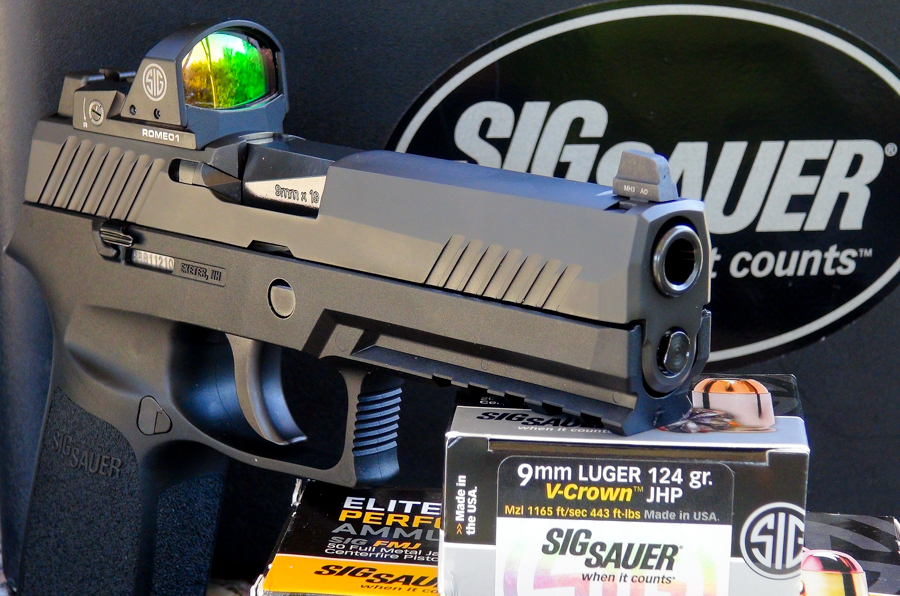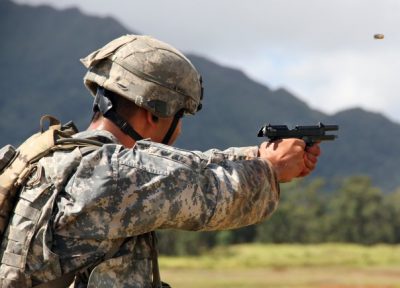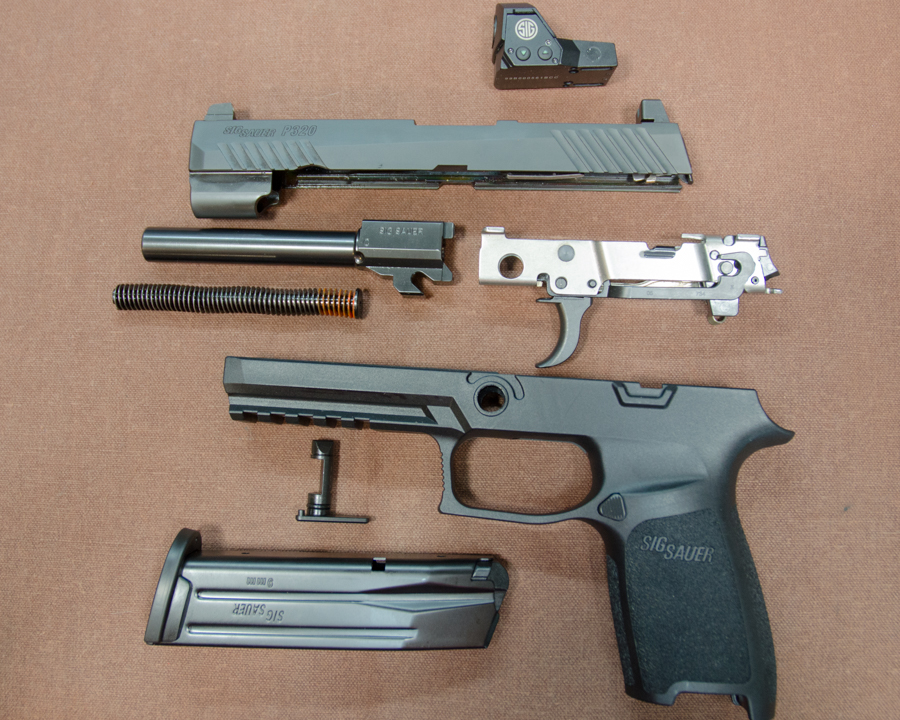
The P320 is without a doubt at the forefront of modern handgun design. But is it right for military duty?
The U.S. Army selected the SIG Sauer P320 as their new sidearm, replacing the iconic and long-lived Beretta M9. While it’s less of a dramatic change than when the military largely shifted from the M1911 to the M9, the Army’s adoption of a polymer-framed, striker-fired service pistol is still big news.
Perhaps the biggest reason is that it was overdue. Without getting into the pros and cons of Beretta’s established yet now-controversial design, the polymer-framed, striker-fired service pistol is the overwhelmingly preferred type of sidearm for militaries worldwide — for decades now.
When you have piles of spare parts, magazines and most importantly, training and facilities for one firearm, it’s hard to argue for a new one. Even if newer designs suit a majority of users better than older guns, making the switch is hard.
With the Army’s previous crop of service pistols reaching its end of life, this was the opportunity to adopt something more modern. This was no surprise to anyone as the search for a new handgun — the Modular Handgun System program — has been running for years.
Whether or not the P320 was the best decision for the military will be hotly disputed for more years than it will even be in service. That’s just the way people roll. But it really is a good decision, and here are six reasons why.
1. Polymer-framed
There really shouldn’t be much argument left in the polymer-versus-metal frame debate. Polymer-framed handguns are more than suited for military service. Under most conditions a polymer-framed handgun will last as long or longer than an alloy- or even steel-framed handgun. They have steel components that may fail over time, just like metal-framed handguns, but these parts are easy to replace, where metal frames are often a loss.
Yes, there are extreme conditions that will break polymers where metal will not suffer damage. But that doesn’t matter with the SIG P320, because the polymer frame, well it isn’t. The P320 is built on a skeletal steel frame. The plastic grip is just a shell. If it breaks it can be replaced as easily as the pistol grip on an M4 carbine. The grip isn’t the gun.
On top of that, the inner steel frame is small and protected by the grip and slide. It should be able to survive, with maintenance, abuses that would trounce most metal-framed guns. This makes it a smart move for economic reasons, too.
2. Low Price

Price was a major factor in selecting Beretta over SIG so many years ago. (Photo: Spc. Paxton Busch)
The P320 is cheap. In a good way. It uses a couple of really genius design elements that make it easy to produce and maintain. In addition to having a completely replaceable exterior and grip, the internal frame is mostly stamped steel. After stamping, critical surfaces are machined to the correct dimensions. Less critical parts are cast (and are also easily replaceable).
The other critical components, like the slide assembly, barrel, and recoil assembly are produced using more or less conventional methods. The top half of the gun handles the bulk of the stress and it’s made like any other SIG. The P320 employs the best of both manufacturing worlds.
How cheap is it? We know the contract is for up to $580 million dollars. The price-per-gun is more complicated because the contract calls for more than just pistols over the course of the next ten years. What’s the bottom line, though? It could be as low as $207 per pistol.
When the military made the change from .45 ACP to 9mm it was SIG’s P226 that led throughout the trials. However, Beretta’s to-be M9 cost less, while performing well enough. Ultimately cheap — when done well — wins.
3. Striker-Fired
And then there’s the fact that it’s a striker-fired handgun. Hammer-fired handguns will always be relevant. They have their strengths and many uses, from casual shooting to professional fighting. But the learning curve slopes more steeply with these guns.
Striker-fired handguns have mass appeal. Just as not everyone in the military is expected to be a warfighter not everyone issued a handgun is expected to be all that good with it. Striker-fired handguns are easier to use and train with.
For shooters looking for a handgun with a crisp, predictable and accurate trigger pull — the P320 has that too. The P320 has a pseudo two-stage trigger. The first stage disengages the firing pin block. The second stage releases the firing pin with a quick, sharp break.
Of course, the P320 isn’t the only modern striker-fired handgun with a nice trigger.
4. True Modularity

The actual firearm is the stainless steel subassembly. Everything else can be swapped out or replaced.
With the P320 users can easily swap parts and adopt different cartridges for different roles and missions. That’s nice, but that itself isn’t new.
The SIG P320 is one of the few guns that can be converted from a subcompact concealed-carry pistol to a full-size duty gun without any special parts or tools. While many other service pistols use the same internal components across the board, the P320 is one of the few handguns that can be readily transformed from one configuration to another.
Readily is key there. There are a few guns that have similar frame and grip setups, SIG has a complete, in-production lineup of conversion kits that’s available now. They also have suppressor-ready and optics-ready parts that are developed and finalized, ready to order.
The P320 in that light is a logistics dream come true.
5. Meets Requirements
And that’s why the Army wanted it. The Army’s Modular Handgun System solicitation was so specific about features it would be easy to assume that it was written specifically so that the P320 and only the P320 would meet all their requirements.
But what came first, the requirements or the SIG, really? When the MHS requirements were published there was enough time for anyone working on next-generation handguns to develop a new gun, or modify an existing gun, to meet them. SIG wasn’t the only company developing guns with these features they just managed to get them all in one package.
Plenty of companies delivered designs that squeaked by the requirements, SIG was just ahead of the game. What’s surprising is that the military put out a set of requirements — and they got what they wanted.
6. Best(-ish) in Class
Finally, there are few reasons to dislike the P320. It doesn’t have any glaring problems or unusual properties that make it suffer. Sure the bore axis is a little high — it’s a SIG, that’s nothing new. Maybe the factory sight picture isn’t the most popular but it still shoots straight.
Maybe it could have a true ambidextrous safety — the standard safety is merely reversible. And maybe it could have been hammer-fired — and then it wouldn’t have qualified for the job.
There are other modern handguns that do some things better. The H&K VP9 has a better grip and by some standards a better trigger. The FNS is fully ambidextrous. The Glock 19 is proven and already in service with American forces. But none of these pack all the required features and failing that, the P320 simply does not have any tangible drawbacks.
It’s maybe a little bland, a little municipal, less sexy than some of the other next-gen service pistols. But it does everything the Modern Handgun System needs it to do and more, and it does it all very well. The P320 is no compromise. That’s why it’s a great choice for the MHS.
Or is it? What do you think the military should have selected? Glock 19M? Something FN-ish? Put the Military back in M&P? Or blast it all, the M1911 did everything just right in the first place!